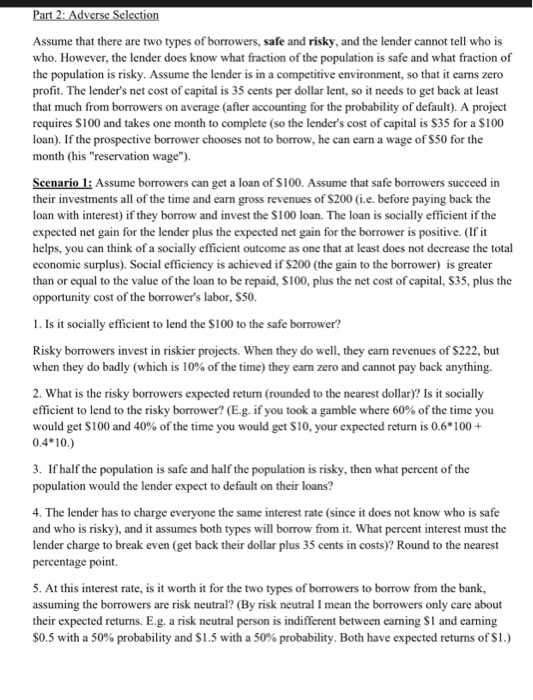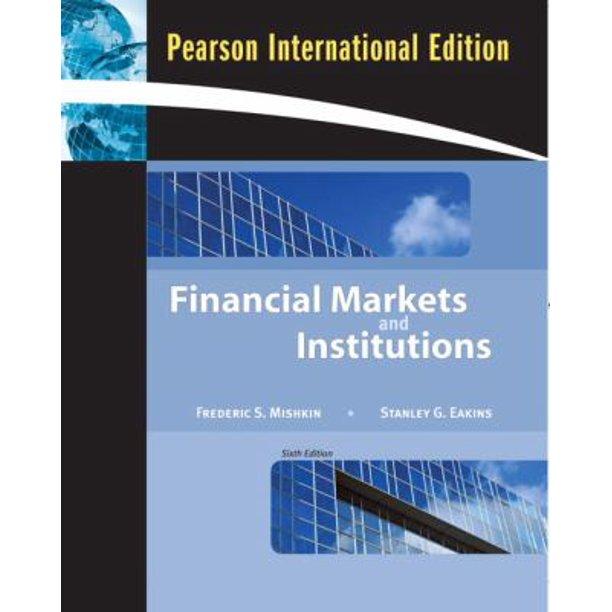Part 2: Adverse Selection Assume that there are two types of borrowers, safe and risky, and the lender cannot tell who is who. However, the lender does know what fraction of the population is safe and what fraction of the population is risky. Assume the lender is in a competitive environment, so that it earns zero profit. The lender's net cost of capital is 35 cents per dollar lent, so it needs to get back at least that much from borrowers on average (after accounting for the probability of default). A project requires $100 and takes one month to complete (so the lender's cost of capital is $35 for a $100 loan). If the prospective borrower chooses not to borrow, he can earn a wage of $50 for the month (his "reservation wage"). Scenario 1: Assume borrowers can get a loan of $100. Assume that safe borrowers succeed in their investments all of the time and earn gross revenues of $200 (i.e. before paying back the loan with interest) if they borrow and invest the $100 loan. The loan is socially efficient if the expected net gain for the lender plus the expected net gain for the borrower is positive. (If it helps, you can think of a socially efficient outcome as one that at least does not decrease the total cconomic surplus), Social efficiency is achieved if $200 (the gain to the borrower) is greater than or equal to the value of the loan to be repaid, $100, plus the net cost of capital, S35, plus the opportunity cost of the borrower's labor, $50. 1. Is it socially efficient to lend the $100 to the safe borrower? when they do badly (which is 10% of the time) they earn zero and cannot pay back anything. 2. What is the risky borrowers expected retur (rounded to the nearest dollar)? Is it socially efficient to lend to the risky borrower? (E.g. if you took a gamble where 60% of the time you would get $100 and 40% of the time you would get $10, your expected return is 0.6*100+ 0.4.10.) 3. If half the population is safe and half the population is risky, then what percent of the population would the lender expect to default on their loans? 4. The lender has to charge everyone the same interest rate (since it does not know who is safe and who is risky), and it assumes both types will borrow from it. What percent interest must the percentage point. 5. At this interest rate, is it worth it for the two types of borrowers to borrow from the bank, assuming the borrowers are risk neutral? (By risk neutral I mean the borrowers only care about their expected returns. E.g. a risk neutral person is indifferent between earning S1 and caring $0.5 with a 50% probability and $1.5 with a 50% probability. Both have expected returns of S1.) 3 of 4 Scenario 2: Now assume that risky borrowers succeed in their investment only 75% of the time (and fail and get a zero return 25% of the time), but they earn revenues of $267 when their 6. What is the risky borrowers expected return (rounded to the nearest dollar)? Is it still socially efficient to lend to them? 7. The population is still half risky and half safe. Again, the lender has to charge everyone the same interest rate (since it does not know who is safe and who is risky), and it assumes both types will borrow from it. What is the interest rate the lender must charge to break even? (It still costs the lender 35 cents per $1 lent.) Round to the nearest percentage point. 8. Is it worth it for both types of borrowers to borrow at this interest rate? (If not, what do you think will happen to the interest rate?) Is this a socially efficient outcome








